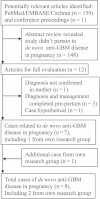Maternal, pregnancy and fetal outcomes in de novo anti-glomerular basement membrane antibody disease in pregnancy: a systematic review
- PMID: 25878776
- PMCID: PMC4379344
- DOI: 10.1093/ckj/sfu086
Maternal, pregnancy and fetal outcomes in de novo anti-glomerular basement membrane antibody disease in pregnancy: a systematic review
Abstract
Background: Outside of pregnancy, anti-glomerular basement membrane (GBM) antibody disease is associated with significant morbidity and mortality. However, there is limited knowledge regarding de novo anti-GBM disease in pregnancy.
Methods: A systematic review was performed to identify maternal, pregnancy and fetal outcomes in de novo anti-GBM disease in pregnancy. Studies were selected from PubMed, EMBASE, Cochrane Library databases and conference proceedings, without language restriction.
Results: Data from eight patients were derived from seven case reports and one unpublished case. Most (6/8) patients presented after the first trimester. During pregnancy, acute kidney injury (5/8), anemia (5/8), hematuria (8/8) and proteinuria (8/8) were common. When hemodialysis was required antepartum (5/8), renal function recovery to independence of renal replacement was unlikely (2/5). While pulmonary involvement was common (5/8), no permanent damage was reported (0/8). The majority of cases ended in live births (6/8) although prematurity (6/6), intrauterine growth restriction (2/6), small for gestational age (4/6) and complications of prematurity (1/6) were common. When anti-GBM levels were tested in the living newborn, they were detectable (2/5), but no newborn renal or lung disease was reported (0/6). Complications in pregnancy included gestational diabetes (3/8), hyperemesis gravidarum (2/8) and preeclampsia (2/8).
Conclusions: Live births can be achieved in de novo anti-GBM disease in pregnancy, but are commonly associated with adverse maternal, pregnancy and fetal outcomes. Only with awareness of common presentations, and management strategies can outcomes be optimized.
Keywords: Goodpasture's disease; anti-GBM; placenta; pregnancy; vasculitis.
Figures
Similar articles
-
De novo antineutrophil cytoplasmic antibody-associated vasculitis in pregnancy: a systematic review on maternal, pregnancy and fetal outcomes.Clin Kidney J. 2018 Oct;11(5):659-666. doi: 10.1093/ckj/sfy011. Epub 2018 Mar 15. Clin Kidney J. 2018. PMID: 30288261 Free PMC article.
-
Goodpasture's syndrome with absence of circulating anti-glomerular basement membrane antibodies: a case report.J Med Case Rep. 2016 Jul 27;10:205. doi: 10.1186/s13256-016-0984-6. J Med Case Rep. 2016. PMID: 27459964 Free PMC article.
-
Goodpasture's disease: a report of ten cases and a review of the literature.Autoimmun Rev. 2013 Sep;12(11):1101-8. doi: 10.1016/j.autrev.2013.06.014. Epub 2013 Jun 24. Autoimmun Rev. 2013. PMID: 23806563 Review.
-
Diagnosis and classification of Goodpasture's disease (anti-GBM).J Autoimmun. 2014 Feb-Mar;48-49:108-12. doi: 10.1016/j.jaut.2014.01.024. Epub 2014 Jan 21. J Autoimmun. 2014. PMID: 24456936 Review.
-
Atypical Goodpasture's disease: a clinical case report and literature review.Ter Arkh. 2018 Jun 20;90(6):130-136. doi: 10.26442/terarkh2018906130-136. Ter Arkh. 2018. PMID: 30701916 Review.
Cited by
-
Anti-glomerular Basement Membrane Glomerulonephritis During the First Trimester of Pregnancy.Intern Med. 2021 Mar 1;60(5):765-770. doi: 10.2169/internalmedicine.5722-20. Epub 2020 Sep 30. Intern Med. 2021. PMID: 32999239 Free PMC article.
-
Granulomatosis with Polyangiitis Presenting as Pauci-Immune Crescentic Glomerulonephritis in Pregnancy.Case Rep Nephrol. 2016;2016:1075659. doi: 10.1155/2016/1075659. Epub 2016 May 11. Case Rep Nephrol. 2016. PMID: 27293925 Free PMC article.
-
Atypical Antiglomerular Basement Membrane Disease in a Pregnant Patient with Systemic Lupus Erythematosus.Case Rep Nephrol. 2023 Nov 11;2023:6963543. doi: 10.1155/2023/6963543. eCollection 2023. Case Rep Nephrol. 2023. PMID: 38028131 Free PMC article.
-
Anti-glomerular basement membrane disease complicated by malaria during pregnancy with successful maternal and fetal outcomes: a case report.J Nephrol. 2024 Dec;37(9):2655-2660. doi: 10.1007/s40620-024-02089-1. Epub 2024 Sep 28. J Nephrol. 2024. PMID: 39340709
-
Approach to Glomerular Disease in Pregnancy.Indian J Nephrol. 2024 Nov-Dec;34(6):561-572. doi: 10.25259/IJN_26_2024. Epub 2024 Jul 15. Indian J Nephrol. 2024. PMID: 39649308 Free PMC article. Review.
References
-
- Couser WG. Rapidly progressive glomerulonephritis: classification, pathogenetic mechanisms, and therapy. Am J Kidney Dis. 1988;11:449–464. - PubMed
-
- Andrassy K, Kuster S, Waldherr R, et al. Rapidly progressive glomerulonephritis: analysis of prevalence and clinical course. Nephron. 1991;59:206–212. - PubMed
-
- Kambham N. Crescentic Glomerulonephritis: an update on Pauci-immune and Anti-GBM diseases. Adv Anat Pathol. 2012;19:111–124. - PubMed
-
- Goodpasture EW. The significance of certain pulmonary lesions in relation to the etiology of influenza. Am J Med Sci. 1919;158:863–870. - PubMed
-
- Benoit FL, Rulon DB, Theil GB, et al. Goodpasture's syndrome: a clinicopathologic entity. Am J Med. 1964;37:424–444. - PubMed
LinkOut - more resources
Full Text Sources
Other Literature Sources


